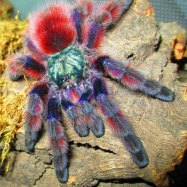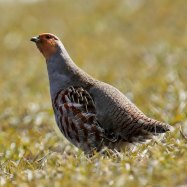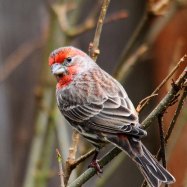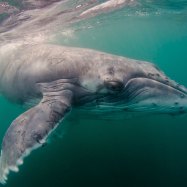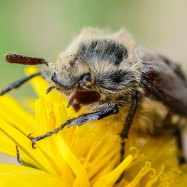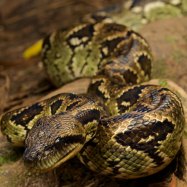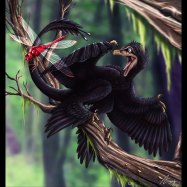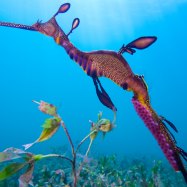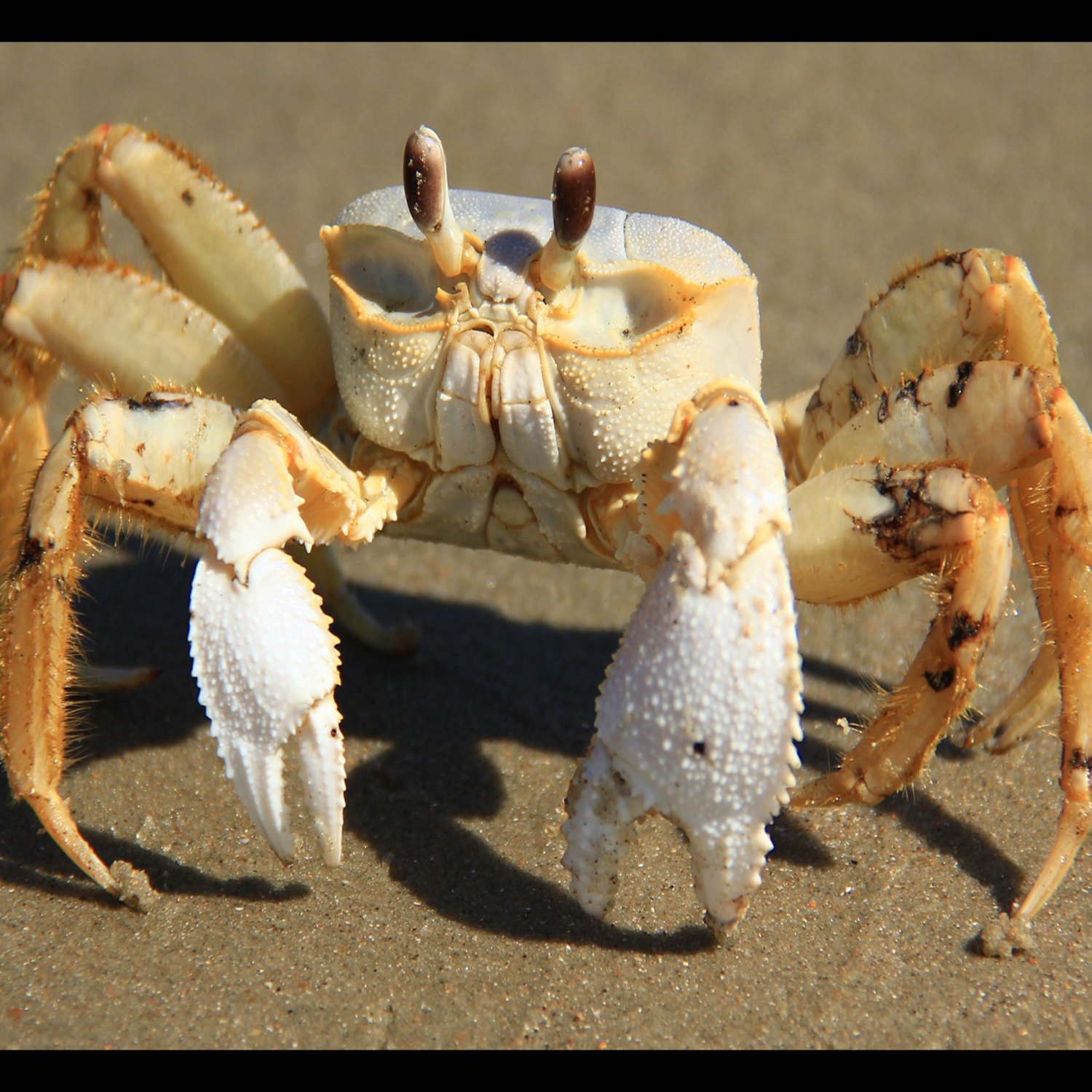
Ghost Crab
Up to 4 inches (10 cm)
The Ghost Crab is a small but fascinating creature found in beaches and coastal areas. With a compact and square-shaped body, it can grow up to 4 inches (10 cm) long. Belonging to the family Ocypodidae, this crab is known for its quick movements and their ability to blend into their surroundings. Keep an eye out for this tiny but mighty crustacean on your next beach trip! #GhostCrab #BeachLife #CoastalAdventures
Animal Details Summary:
Common Name: Ghost Crab
Kingdom: Animalia
Habitat: Sandy beaches, intertidal zones
The Fascinating World of the Ghost Crab: An Elusive and Mysterious Beach Dweller
The sandy beach stretches out before you, the salty sea breeze gently blowing through your hair. The sound of waves crashing on the shore fills your ears, the sun setting on the horizon painting the sky in a warm golden hue. As you take in the tranquility of the moment, a small creature scurries across the sand and disappears into its hole. This is the elusive and mysterious world of the ghost crab Ghost Crab.Scientifically known as Ocypode, the ghost crab is a species of crustacean that inhabits sandy beaches and intertidal zones across the globe. Despite its spooky name, this crab is actually quite fascinating and has become a popular sight for beachgoers and avid wildlife enthusiasts alike.
The ghost crab belongs to the Animalia kingdom, making it an animal, and the Arthropoda phylum, placing it in the same category as insects and spiders. It falls under the Malacostraca class, which includes crustaceans such as lobsters and shrimps. Within this class, the ghost crab belongs to the Decapoda order, meaning it has ten legs, and the Ocypodidae family.
They can be found in coastal areas worldwide, making them a truly global species. However, the specific country of origin varies depending on the species. Ghost crabs can be found in beaches and coastal areas all over the world, making them a common sight for beachgoers in locations such as the United States, Australia, and South Africa.
One of the most distinctive features of the ghost crab is its unique coloration Giant Trevally. While it does have the ability to blend in with its surroundings, the ghost crab is commonly found in earth tones, such as shades of brown, gray, and white. This coloration allows them to camouflage themselves against the sandy beach, making them quite elusive, even to the trained eye.
The body shape of the ghost crab is another standout feature. Unlike most crabs, which have a triangular or oval shape, the ghost crab has a more compact and square-shaped body. This body shape is a clever adaptation that allows them to move quickly and efficiently through sandy terrain.
On average, ghost crabs can grow up to 4 inches (10 cm) in length, with some species even reaching lengths of up to 6 inches (15 cm). While this may seem small, they are actually quite formidable creatures in their own right, with powerful claws and a strong exoskeleton to protect them.
When it comes to their diet, ghost crabs are omnivorous, meaning they will eat both plant and animal matter. They are known to scavenge for food, feeding on anything from small insects to seaweed, and even dead fish that wash up on the shore. This feeding method makes them crucial members of their ecosystem, helping to maintain a balance in beach habitats.
One of the most fascinating aspects of the ghost crab is its habitat. As their name suggests, they are commonly found living in sandy beaches, more specifically in the intertidal zone. This is the area between the high and low tide marks, making it a constantly changing environment. Ghost crabs have adapted to this ever-changing habitat, building burrows deep into the sand to protect themselves from the elements.
But these burrows aren't just for protection; they also serve as homes for the ghost crab. They create intricate network systems of tunnels, with multiple entrances and even separate chambers for different purposes. These tunnels also serve as a way for ghost crabs to regulate their body temperature, as the sand acts as a natural insulator.
But what sets this species apart from other crabs is their elusive nature. As mentioned before, they are quick to disappear into their burrows at any sign of danger, making it quite challenging to observe them in their natural habitat. This elusive behavior is what earned them their spooky name – ghost crab.
The ghost crab is a protected animal, and in some areas, it is illegal to harm or disturb them. This is because they play a vital role in their ecosystem, helping to keep beaches clean by feeding on dead organisms and other debris. They also serve as prey for larger animals, such as birds and fish, making them an essential part of the food chain in coastal environments.
Unfortunately, despite being a protected species, ghost crabs face many threats to their populations. One of the major threats is human disturbance, as tourists and beachgoers may unknowingly damage their burrows or even step on them. Pollution, habitat destruction, and climate change also pose significant dangers to ghost crabs and their coastal habitats.
But there are ways that we can help protect these fascinating creatures. By being mindful of our actions when visiting beaches, especially areas where ghost crabs are known to live, we can help minimize our impact on their home. Proper waste disposal, avoiding disturbing their burrows, and respecting their natural behavior are just some simple ways we can protect the ghost crab and its habitat.
In conclusion, the ghost crab may be a small creature, but it has undoubtedly captured our fascination and curiosity. With its elusive nature, unique coloration, and remarkable adaptations, it's no wonder that this beach dweller has become a popular sight for many. Whether you're a beachgoer, a wildlife enthusiast, or simply someone looking to learn more about the diverse species on our planet, the ghost crab is a must-see and a true marvel of the natural world.

Ghost Crab
Animal Details Ghost Crab - Scientific Name: Ocypode
- Category: Animals G
- Scientific Name: Ocypode
- Common Name: Ghost Crab
- Kingdom: Animalia
- Phylum: Arthropoda
- Class: Malacostraca
- Order: Decapoda
- Family: Ocypodidae
- Habitat: Sandy beaches, intertidal zones
- Feeding Method: Omnivorous
- Geographical Distribution: Found in coastal areas worldwide
- Country of Origin: Varies depending on species
- Location: Beaches, coastal areas
- Animal Coloration: Varies depending on species, commonly earth tones
- Body Shape: Compact and square-shaped
- Length: Up to 4 inches (10 cm)
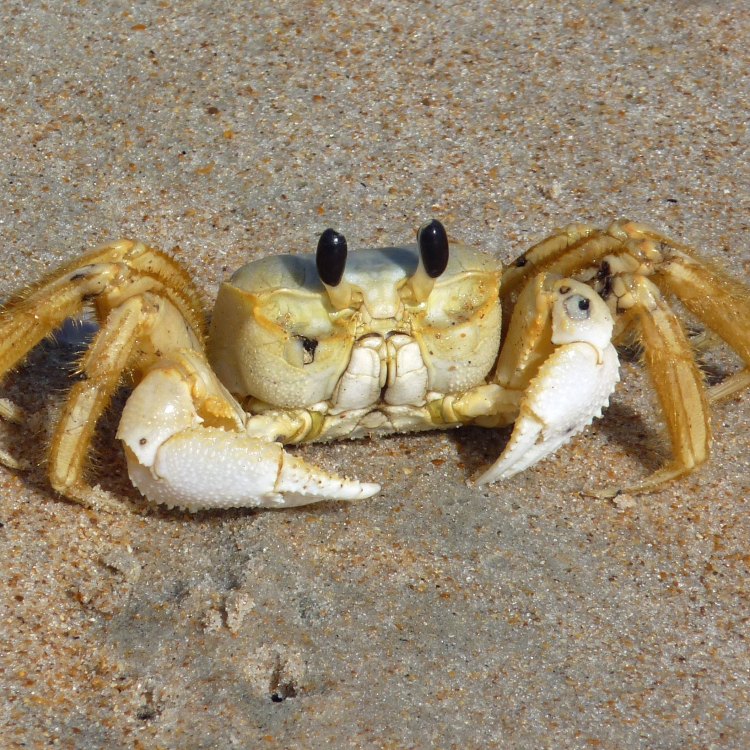
Ghost Crab
- Adult Size: Varies depending on species
- Average Lifespan: Up to 3 years
- Reproduction: Sexual
- Reproductive Behavior: Mating occurs on land, females carry eggs and release larvae into the ocean
- Sound or Call: No specific sound or call
- Migration Pattern: Some species exhibit seasonal migrations
- Social Groups: Solitary
- Behavior: Nocturnal, burrow in the sand during the day, emerge at night to feed
- Threats: Habitat loss, pollution, predation
- Conservation Status: Varies depending on species
- Impact on Ecosystem: Play a role in beach ecosystem dynamics
- Human Use: Sometimes collected for aquarium trade
- Distinctive Features: Elongated eyes, large front claws
- Interesting Facts: Can change color to blend with the sand, can run quickly, have excellent vision
- Predator: Various shorebirds, crustaceans, fish
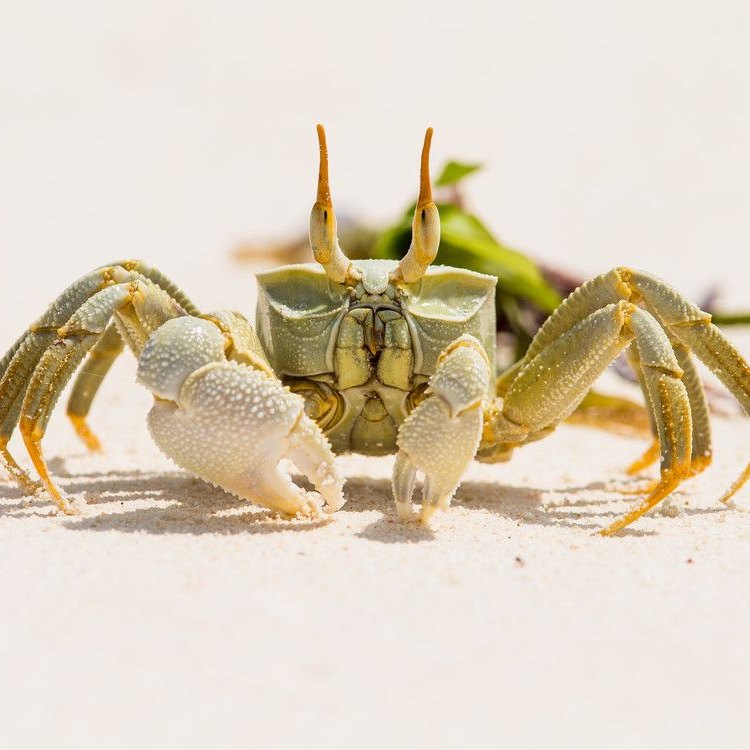
Ocypode
The Elusive Ghost Crab: A Fascinating Creature of the Beach
The beach is a place of relaxation, sun, and fun for many people. But hidden within the sand and waves lies a creature that many beachgoers may not even notice – the ghost crab. These small, nocturnal creatures are a vital part of the beach ecosystem and possess unique features that make them a truly fascinating species.So what exactly is a ghost crab? To put it simply, they are small crabs that live on sandy beaches PeaceOfAnimals.Com. But there is much more to these elusive creatures than meets the eye. Let's delve deeper into the world of the ghost crab and discover what makes them such an intriguing species.
The Basics: Adult Size, Lifespan, Reproduction, and Behavior
Ghost crabs are found on sandy beaches all around the world, with different species inhabiting different regions. Depending on the species, their adult size can vary, with some reaching up to 3 inches in length. Their average lifespan is around 3 years, with some species living even longer.One fascinating aspect of ghost crab behavior is their reproductive process. Unlike some other species of crabs, ghost crabs reproduce sexually. This occurs on land, with the male crab performing a complex dance to attract a female mate. Once they have mated, the female will carry the eggs and release larvae into the ocean, where they will continue to develop Groenendael.
Ghost crabs are known for their nocturnal behavior, choosing to hide in their burrows during the day and emerging at night to forage for food. This behavior is believed to be a survival mechanism, as it helps the crabs avoid predators and the heat of the sun. They are also known for their impressive speed, being able to run quickly to escape danger or catch their prey.
The Elongated Eyes and Large Claws: Distinctive Features of Ghost Crabs
One of the most distinctive features of ghost crabs is their elongated, stalked eyes. These eyes provide the crabs with excellent vision, allowing them to spot predators and prey from a distance. They are also able to swivel their eyes independently, giving them a 360-degree view of their surroundings.In addition to their eyes, ghost crabs also have large front claws, also known as chelipeds. These claws are used for various purposes, including digging their burrows, catching prey, and even communication with their fellow crabs.
Adaptations for Survival: Camouflage and Blending In
One of the most interesting facts about ghost crabs is their ability to change color to blend in with their surroundings. Their carapace, the hard shell covering their body, can range in color from black to pale white. This color change helps the crabs blend in with the sand, making them difficult to spot by predators.In addition to changing color, ghost crabs also have a unique method of camouflage. They collect balls of damp sand and use their claws to stick the sand onto their bodies, creating a sand armor. This helps them blend in with their surroundings and provides an extra layer of protection against predators.
The Role of Ghost Crabs in the Ecosystem
As mentioned earlier, ghost crabs are a vital part of the beach ecosystem. They are considered to be key species in beach dynamics, as their burrowing behavior helps to aerate and mix the sand, allowing for nutrient transport and promoting the growth of plant and animal life on the beach.Ghost crabs also play a role in the food chain, serving as both predator and prey. They feed on small invertebrates and detritus, while also being a food source for various shorebirds, crustaceans, and fish.
Threats to Ghost Crabs and Conservation Efforts
Like many other species, ghost crabs face numerous threats to their survival, the most significant being habitat loss and pollution. As coastal development continues to expand, the natural beach habitats that ghost crabs rely on are diminishing. Pollution, such as plastic and oil, also pose a threat to these creatures and can cause harm or death if ingested.The conservation status of ghost crabs varies depending on the species and their location. Some species are considered to be of least concern, while others are facing threats or are even endangered. Conservation efforts are focused on preserving beach habitats, reducing pollution, and raising awareness about the importance of these creatures in the ecosystem.
Human Use: Ghost Crabs and the Aquarium Trade
Although ghost crabs are not considered popular seafood, they are sometimes collected for the aquarium trade. In some countries, they are sold as pets, but it is important to note that this can have a negative impact on their population if not done sustainably. It is crucial to be responsible when purchasing ghost crabs for aquariums and to ensure they are not taken from the wild.In Conclusion
In the vast world of beaches and oceans, the ghost crab is a small but highly fascinating creature. From their unique adaptations for survival to their important role in the ecosystem, these small crabs have a lot to offer. As we continue to explore and enjoy our beaches, let us also remember to protect and preserve these amazing creatures for generations to come. Next time you take a stroll on the beach, keep an eye out for the elusive ghost crab, and appreciate the hidden beauty of this remarkable species.
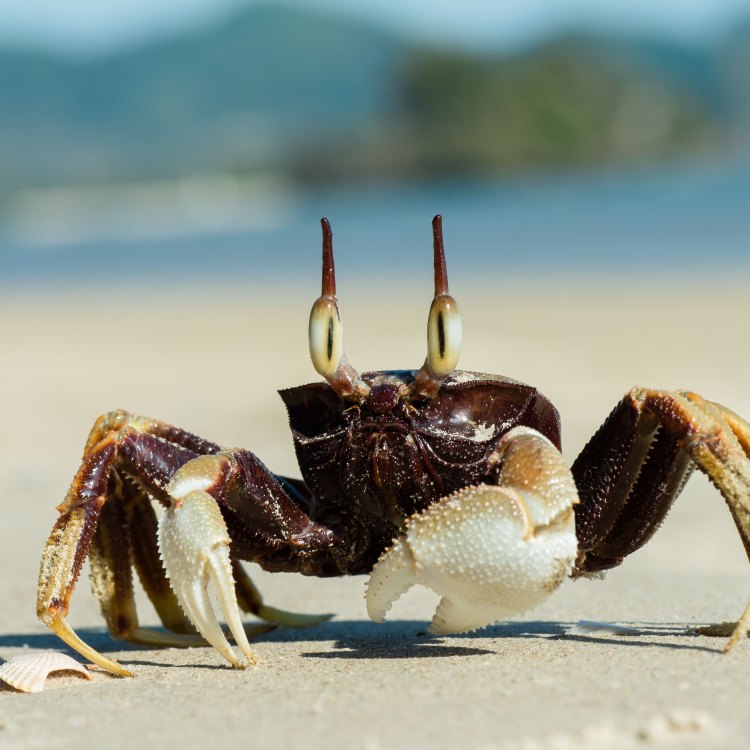
The Fascinating World of the Ghost Crab: An Elusive and Mysterious Beach Dweller
Disclaimer: The content provided is for informational purposes only. We cannot guarantee the accuracy of the information on this page 100%. All information provided here may change without prior notice.



